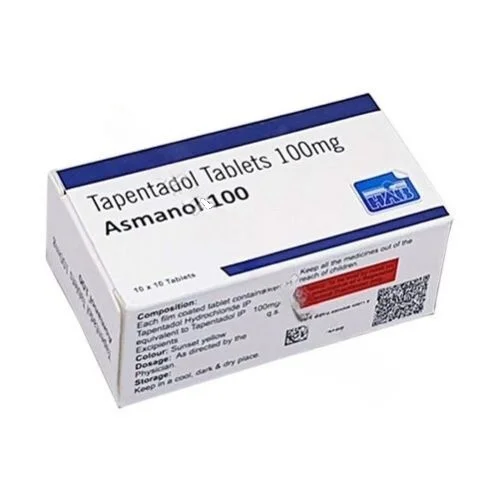Introduction
Pain management is an important element of healthcare, and there are many drugs available to assist people manage different kinds of pain. Tapentadol stands out because of its dual mode of action. Tapentadol, sold under many trade names such as Asmanol 100 mg and Tap 100 mg, is a powerful analgesic used to treat moderate to severe pain. This page gives a detailed review of Tapentadol 100 mg, including its mechanism, indications, dosage, side effects, and precautions.
Mechanism of Action.
Tapentadol has two basic modes of action, making it unusual among pain relievers:
Tapentadol binds to mu-opioid receptors in the brain, reducing the sense of pain. This process is comparable to typical opioids, but tapentadol is thought to have a decreased risk of addiction and dependency.
Norepinephrine reuptake inhibition: Tapentadol, in addition to its opioid action, decreases norepinephrine reuptake. This strengthens the body’s natural pain-fighting capabilities and adds to its analgesic properties. Tapentadol may successfully control pain by boosting norepinephrine levels without depending primarily on opioid pathways, possibly lowering the risk of opioid-associated adverse effects.
Indications
Tapentadol 100 mg is recommended for the following pain conditions:
Acute pain: This includes post-surgical pain, injury-related pain, and other severe pains that need to be managed in the near term. Its quick start of effect makes it ideal for acute pain alleviation.
Chronic Pain: Tapentadol is also useful for treating chronic pain problems such as osteoarthritis, lower back pain, and neuropathic pain. Its dual method of action may be very useful for chronic pain sufferers who do not react well to conventional analgesics.
Dosages and Administration
Tapentadol dose should be customized to the patient’s particular requirements. Below are some basic guidelines:
Initial dose for acute pain: A normal initial dosage for acute pain is 50 mg to 100 mg given every 4 to 6 hours as required. The precise dose will be determined by the patient’s pain level and reaction to the medicine.
Chronic Pain Management: To control continuing pain, the dosage may be modified depending on the patient’s reaction and tolerance. A typical regimen can include a regular schedule of dosages to provide constant pain relief.
To minimize any negative effects or dependency, follow the doctor’s instructions and do not exceed the specified dosage.
Tapentadol 100 mg (Asmanol 100 mg or Tap 100 mg) might have negative effects, just like any other medicine. Typical side effects include:
Nausea is one of the most often reported adverse effects. Taking the drug with meals may help to relieve nausea.
Dizziness: Patients may feel dizziness, particularly while beginning the medicine or increasing the dosage.
Constipation: Some opioid drugs, like Tapentadol, may induce constipation. Patients are typically advised to drink lots of water and may need a laxative.
Drowsiness: Tapentadol may produce drowsiness, thus patients should use caution while driving or using heavy equipment until they understand how the medicine affects them.
Severe side effects that need urgent medical care include:
Respiratory Depression: A severe adverse effect in which breathing becomes sluggish and shallow. It is more likely to occur when the medicine is used in large dosages or in combination with other respiratory depressants.
Severe allergic reactions include redness, itching, swelling, severe disorientation, and difficulty breathing.
Tapentadol may cause serotonin syndrome, an uncommon but potentially fatal illness when combined with other drugs that impact serotonin levels. Symptoms include disorientation, agitation, fast heart rate, and elevated blood pressure. Take precautions.
To ensure the safe use of Tapentadol, patients should notify their healthcare practitioner about:
History of drug or alcohol abuse: Tapentadol has the potential for addiction and dependency, thus clinicians must determine whether the patient has a history of drug abuse.
Pre-existing Medical Conditions: Respiratory concerns, liver or renal problems, and mental health conditions may all have an impact on how the body processes Tapentadol.
Other medications: It is critical to prevent possible medication interactions. Patients should give a comprehensive list of any medicines they are presently on, including over-the-counter medications and vitamins.
Comparing Asmanol 100 mg with Tap 100 mg
Tapentadol is sold under the brand names Asmanol 100 mg and Tap 100 mg, and both products contain the same active component and have comparable effects. The decision between them may be determined by availability, patient preferences, and advice from healthcare providers. Both are effective for treating moderate to severe pain, making use of Tapentadol’s dual mechanism of action to provide complete pain relief.
Patient Reviews and Experiences
Patient evaluations emphasize the efficacy of Asmanol 100 mg and Tap 100 mg in pain management. Many patients have reported great pain alleviation and increased quality of life. However, some people report adverse symptoms including nausea and dizziness. Overall, patient experiences highlight the significance of personalized treatment programs and frequent engagement with healthcare practitioners.
visite sitemap:https://www.pills4cure.com/sitemap.xml
Conclusion
Tapentadol 100 mg, also known as Asmanol 100 mg or Tap 100 mg, is a flexible and effective medicine for treating moderate to severe pain. Its dual method of action gives it a distinct benefit in pain treatment since it inhibits norepinephrine reuptake as well as opioid receptors. While it is typically well accepted, patients should be aware of possible adverse effects and use the medicine with care. Tapentadol 100 mg, when used under good medical care, may considerably improve pain management and quality of life for patients.


